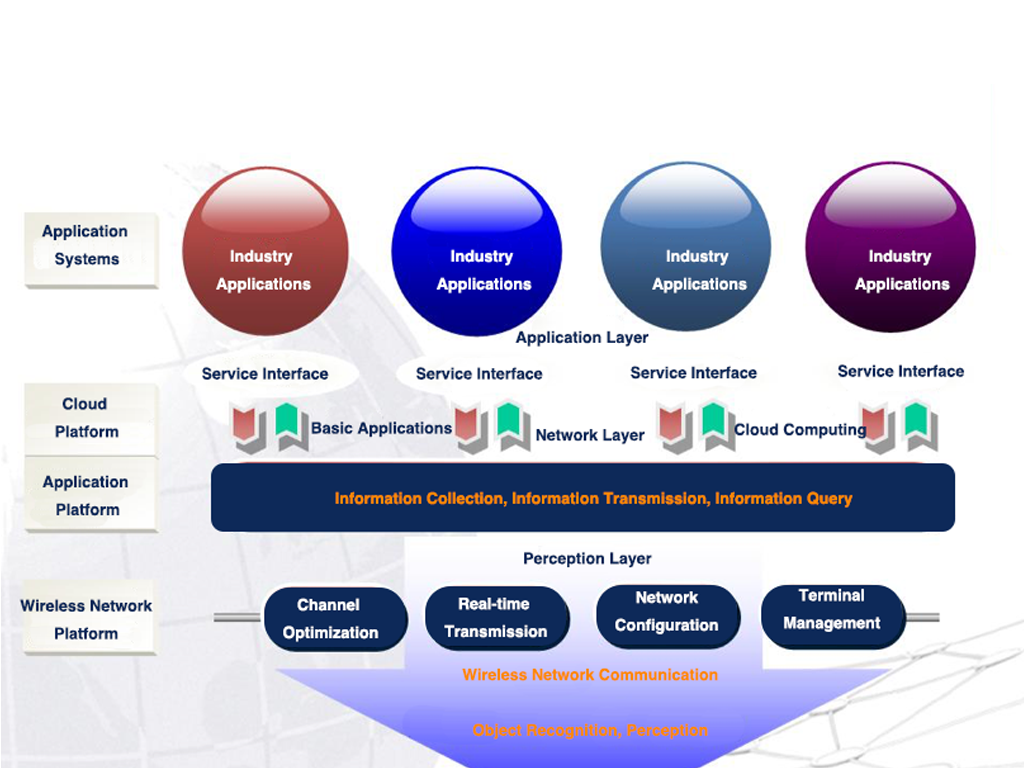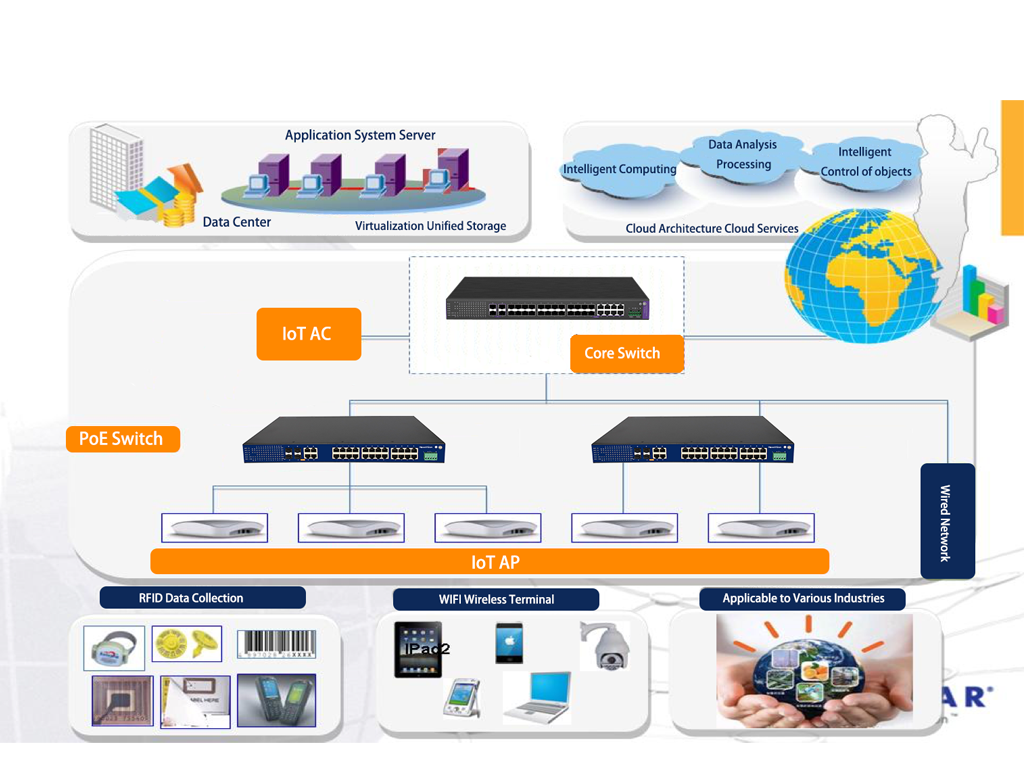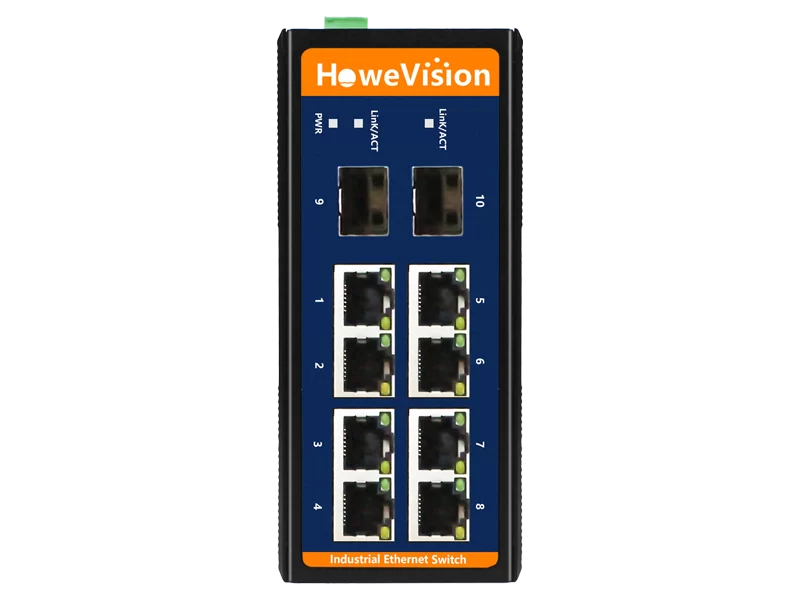IoT Transmission Solution
Table of Contents
Introduction
The Internet of Things is a highly integrated and comprehensive application of a new generation of information technology. It is based on the actual management and application needs in the social and economic fields. It uses sensing technology and intelligent devices to sense and identify the physical world. Through the transmission interconnection of the Internet and mobile communication networks, computing, processing, and knowledge mining are carried out. Realize human-object and object-object information interaction and seamless linkage. Enhance the ability of humans to control the physical world in real-time, precise management, and optimal allocation of resources, To realize the scientific and intelligent decision-making of production and life.
The construction of the innovative city Internet of things includes the structure of the perception layer, network layer, and application layer. The perception layer consists of deploying, accessing, and managing barcode readers, RFID readers, sensors, cameras, and other perception devices. The sensing equipment sends the collected signals to the IoT network layer through the M2M terminal and Internet gateway. The construction of the IoT network layer includes the construction of an IoT information center and IoT management center. The IoT information center is a collection of the information base and computing power for data collection, which belongs to the big data platform. The IoT management center is mainly for the unified coding, authentication, authentication, and billing of IoT data. Through the information center and management center of the essential IoT data capability provision and management. Realize the construction of IoT application layers, such as telemedicine, intelligent transportation, industrial monitoring, environmental monitoring, public safety, urban governance, and other innovative city applications.
IoT Transmission Pain Points Analysis.
- With the popularity of the Internet of Things in manufacturing, transportation, energy, electricity, home, medical, and other fields, the number of different types of devices and data is increasing, so the security challenges facing the Internet of Things are becoming increasingly severe. Solving the security of networked communication is one of the primary problems of IoT communication.
- Part of the IoT solution architecture uses a centralized server model; with the geometric growth of the number of devices, Reaching an unprecedented level, the contradiction between cost and scale is gradually highlighted, and the cost of centralized services is unaffordable. At the same time, the collected data often lacks the step of in-depth analysis and decision refinement, which is difficult to link with the actual value. How to solve the problem of rigid IoT architecture through a flexible and versatile communication architecture so that the network is more relevant to the actual application of IoT needs more targeted network communication products.
- More and more IoT application scenarios need to go beyond a single company or organization, involving cross-subjects and collaboration between multiple peer entities. It may contain suppliers, manufacturers, distributors, platform parties, service providers, end-users, financial and insurance institutions, and many other roles when the time cost of establishing trust and communication costs are high. Communication compatibility: IoT devices are often compatible with various communication protocols, i.e., to cover Zigbee, Wi-Fi, Bluetooth, and other close-range communication, and consider NB-IoT, LoRa, and other long-range transmissions. There are many data models, interface specifications, network protocols, and other standards for different application scenarios, making interconnection more difficult, inevitably forming information islands, and reducing communication efficiency. The synergy problem of communication is gradually highlighted, and it is imperative to solve the problem of efficient compatibility of multiple subjects fully.
The Internet of Things Communication Network Development Analysis
The Internet of Things (IoT) is an “Internet of Things” covering everything in the world based on the computer Internet. All objects are connected to the Internet through information sensing devices to exchange information for intelligent identification and management. The development of IoT is divided into three stages.
The First Stage of IoT Development
IoT connection large-scale establishment stage, more and more devices put into the communication module through the mobile network (LPWA/GSM/3G/LTE/5G, etc.), Wi-Fi, Bluetooth, RFID, ZigBee, and other connection technologies connected to the network. In this stage of network infrastructure construction, connection construction, and management, terminal intelligence is the core. Insights expect that by 2020, the global IoT access devices will reach 30 billion units. By that time, only 15% of these 30 billion devices will be electronic devices used by people for daily use to communicate or access the Internet. The other 85% will be “things” connected to the Internet – including commercial, industrial, and consumer electronic systems, distributed sensor systems, automobiles, and other connectable devices. The main opportunities in this phase are network infrastructure construction, communication chips, and modules, various sensors, connection management platforms, measurement meters, etc.
In The Second Stage of IoT Development
the state of many devices connected to the network is sensed, generating massive data and forming IoT big data. At this stage, sensors, meters, and other devices are further intelligent, and diverse data are perceived and collected, and gathered to the cloud platform for storage, classification, processing, and analysis; at this time, IoT also becomes one of the largest business of cloud computing platform. According to IDC’s forecast, the total global data in 2020 will exceed 40ZB (equivalent to 4 trillion GB). This amount of data will be 22 times more than in 2012, with a compound annual growth rate of 48%. This phase will see the rapid development of cloud computing and the Internet of Things. The main opportunities in this stage are the AEP platform, cloud storage, cloud computing, data analytics, etc.
The Third Stage of IoT Development
Initial artificial intelligence has been achieved, intelligent analysis of IoT generated data, and IoT industry applications and services will reflect the core value. Gartner predicts that in 2020 IoT applications and services value will reach $262 billion, and the market size is more than four times the IoT infrastructure sector. IoT data will have the most excellent value at this stage, and companies will analyze the sensed data and use the results to build solutions for commercial realization. At the same time, operators are sitting on a large amount of user data information, through the completion of data will significantly improve the operator’s revenue. The main opportunities in this stage are IoT integrated solution providers, artificial intelligence, machine learning vendors, etc.
The current stage of IoT is that many devices need to be networked, and communication problems need to be solved. IoT communication network is divided into wired IoT and wireless IoT. Wired IoT is characterized by stable signal, strong anti-interference ability, and sound real-time data transmission. The disadvantage is that it requires wiring, space occupation, high installation, maintenance costs, and is not flexible enough. Therefore, wired IoT is mainly suitable for some occasions with high requirements for reliability and real-time, especially for some industrial circumstances. The characteristics of wireless IoT are no wiring, flexible installation, space-saving, and low cost. The disadvantage is that the anti-interference performance is relatively poor, and the real-time data transmission is also rather poor. Wireless IoT is mainly suitable for occasions with low reliability and real-time requirements but high installation and maintenance costs and flexibility requirements. In recent years, the massive development of terminal devices has promoted the application of wireless Internet of Things, and what we perceive as the “Internet of Things” (IoT) has become “Wireless Internet of Things” (Wireless Internet of Things). Wireless Internet of Things. Wireless Internet of Things communication network is divided into Wireless Wide Area Network (WWAN), Wireless Metropolitan Area Network (WMAN), Wireless Local Area Network (WLAN), and Wireless Personal Area Network (WPAN) according to the distance network. A wireless personal area network is a wireless communication network that is established to realize a small activity radius, rich service type, group-oriented, and seamless wireless connection. WPAN is at the end of the whole wireless network and can effectively solve the problem of “the last few meters of cable.” The coverage range of wireless LAN and personal area networks is between tens and hundreds of meters, which is also called short-range wireless communication. As short-range wireless communication is in the last mile of wireless networks, most items need to rely on short-range wireless technology to interconnect when realizing IoT.
Short-range communication technology is generally used in smart homes, industrial data collection, and other local area network communication scenarios. Its advantages are low deployment cost, low power consumption, and high transmission rate. But the disadvantage is also apparent — short transmission distance (generally within a few tens of meters). It cannot meet the interconnection of multiple short-range IoT before and can not be directly connected to the cloud platform. Wireless low-power wide-area networks such as MTC, LoRa, and NB-IoT are “wide area” networks. They necessarily involve network operation and require operators to invest in deploying many base station equipment and corresponding core network equipment, resulting in high comprehensive costs. The use of low-cost and mature short-range wireless technology and existing optical fiber wired networks for IoT deployment can give full play to the advantages of both networks and maximize the use of existing mature technology resources to achieve low-cost deployment of IoT has essential application value.
The Application and Development Trend in PoE IoT
PoE In The Field of IoT Application Value.
The Internet of Things (IoT) equips sensors to various natural objects such as power grids, railroads, bridges, tunnels, highways, buildings, water supply systems, dams, oil and gas pipelines, and household appliances and connects them via the Internet. In order to run specific programs to achieve remote control or direct communication between things. The Internet of Things allows centralized management and control of machines, equipment, and people by a central computer, remote control of home equipment and cars, and various applications to locate and prevent theft of goods. In many of the above applications, a power supply technology is missing. PoE (Power Over Ethernet) is a technology that can be used to transmit power and data to devices over twisted pair cables in Ethernet. Through this technology, devices such as VoIP phones, wireless base stations, network cameras, hubs, intelligent terminals, modern intelligent office equipment, and computers can be powered by PoE technology to complete the operation of various devices. Since electronic devices powered by Ethernet can be used without additional power outlets, it saves time and money to configure power cables and reduces the cost of the whole system. PoE does not need to change the Ethernet cable structure to operate, so the PoE system saves cost, is easy to install, and can power on and off remotely, which is an excellent solution to the power supply problem of IoT terminals. It will play a significant role in the future development of the Internet of things.
Application of PoE In the Internet of Things.
With the development of technology and application, the connotation of IoT has been expanded, and a new understanding has emerged – IoT is an extended application and network extension of communication networks and the Internet. It uses perception technology and intelligent devices to perceive and identify the physical world. It interconnects through network transmission, computation, processing, and knowledge mining to achieve human and object, object, and object information interaction and seamless connection to achieve real-time control, precise management, and scientific decision-making of the physical world. Therefore, the network will no longer passively meet users’ needs but will actively sense the changes in user scenarios and interact with information to provide personalized services to users. The following are the main application scenarios of current PoE technology in IoT.
PoE Wireless AP In The IoT
The influence of wireless network technology on people is indisputable, and the application scope of wireless LAN is more and more extensive. Large offices, intelligent warehouses, university campuses, shopping malls, airports, convention centers, hotels, airports, hospitals, bars, coffee houses, etc., to realize people’s need to access the Internet anytime and anywhere. The most critical work in deploying a wireless network is the proper and effective installation of wireless AP (Access Point). In larger wireless network coverage projects, the number of wireless APs is large and distributed in various building parts. AP generally requires network cables to connect to switches and external DC power supplies. The local solution of power supply and management will significantly increase the cost of construction and maintenance. The centralized power supply problem of wireless APs is solved through Power over Ethernet (PoE), which can substantially solve the issues of local power supply and future AP management encountered in the project construction. It avoids that individual APs cannot be typical when there is a regional power outage. This solution uses AP equipment with 802.3af protocol support to achieve the Power over Ethernet function. If the AP does not support the 802.3af protocol function can be taken to directly add data and PoE synthesizer to complete this power supply function, As shown in the figure below.
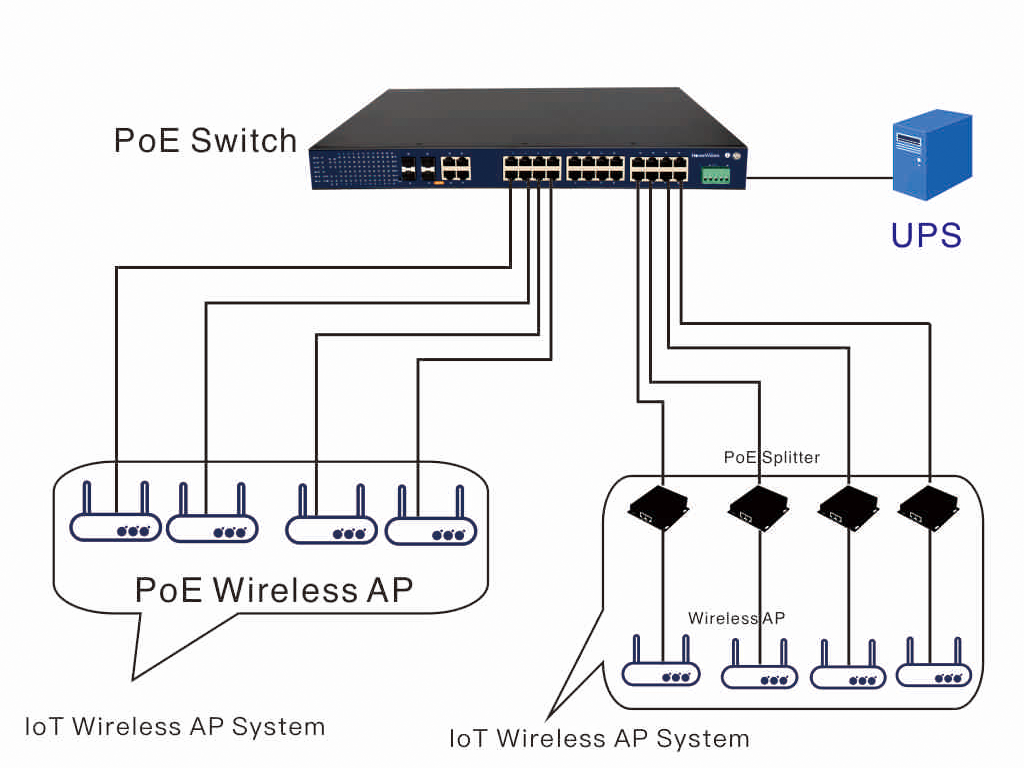
PoE Remote Monitoring In the Internet of Things
In recent years, due to the rapid development of the social economy and information technology, the country’s various industries have generated unprecedented demand for video surveillance. Application areas are becoming more and more extensive. In addition to finance, government, transportation, and other unique industries, communities, hotels, public places, factories, and shopping malls have implemented digital surveillance. The scale and radiation area are getting bigger and bigger. A typical example is the “Safe China” project, whose project scope involves the entire city with tens of thousands of cameras. And video surveillance products also from the local DVR approach to IP Camera network development.
However, the installation of network video surveillance equipment is constrained by the environment, which seriously affects the development of network video surveillance. Surveillance network cameras are used in addition to the need to transmit the video signal through the network cable. Still, they also must provide sufficient power for it around the clock. In the implementation process, the camera’s installation location has to be redesigned because of the inability to provide a stable power supply, and redesigning the installation location may lead to monitoring dead spots, making security monitoring meaningless.
Usually, the regular work of the network camera requires two external wires, a network cable and a wire. And the following circumstances will lead to a network monitoring lens can not being installed.
- The camera installation location is without power.
- The camera installation location has a power supply but is a lighting power supply and can not provide an all-weather power supply.
The above situations that lead to the network camera not being installed all occur in the camera power supply problems. To make the network camera installed correctly in the expected location. It is necessary to solve the power supply problem of the network camera. Since the power cannot be adequately provided, you should consider using a network cable to power the camera. After all, it is much easier to deploy a network cable than a strong wire. If you use a network cable to power the network camera, the network camera can work properly as long as the power at the data switch end is not interrupted. The wires used to power the network camera can be summarized in two cases.
- the network camera supports the 802.3af protocol; you can directly use the PoE power supply device to power the network camera through the network cable.
- the network camera does not support the 802.3af protocol and can not directly use the PoE device power supply. At this time, you need to use another supporting equipment – a splitter. The role of the separator can be integrated with power network cable separated into pure data network cable and power cable. As shown in the figure below, it will complete the separation of data and power to achieve a network cable that transmits data and provides energy.

PoE Intelligent Terminal In The Internet of Things
When you make a phone call at home, the call will not be interrupted if the power is suddenly cut off. Because the power supply of the telephone terminal is directly supplied by the telephone company (local) exchange through the telephone line, imagine if the sensors, controllers, and intelligent terminals in industrial sites in the IoT and modern office equipment can also be powered by Ethernet directly. The total cost of wiring, power, labor, etc., could be reduced significantly. In June 2003, IEEE approved the 802.3af standard, which specifies power detection and control in remote systems, and determines how routers, switches, and hubs can power devices such as IP phones, security systems, and wireless LAN access points over Ethernet cables. The release of IEEE 802.3af has dramatically advanced the development and application of PoE technology. PoE technology-based industrial Ethernet products have been launched to provide reliable and stable power supply for various network terminals in IoT industrial control, such as temperature detection terminals, humidity detection terminals, signal control terminals, etc. It shows below.
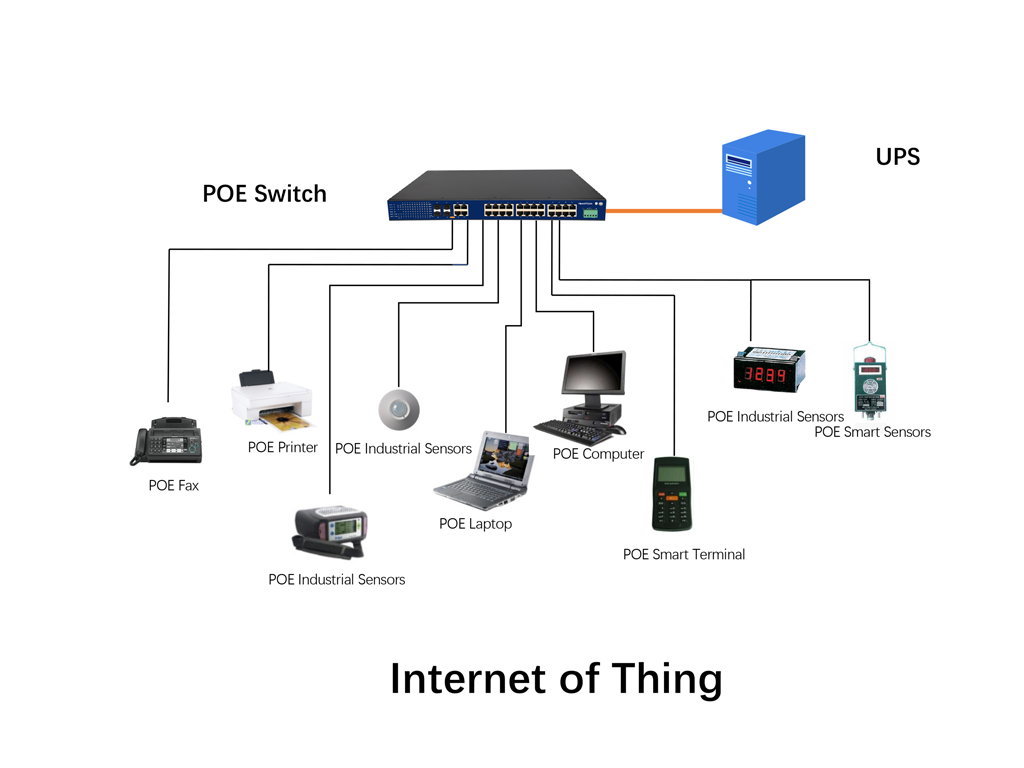
PoE Development will Facilitate IoT Communications
IoT is an all-inclusive, comprehensive network, Ethernet is an effective transmission method in IoT, and Power-On-Ethernet (PoE) is a revolutionary technology. PoE will change how network devices are powered, allowing network administrators to maximize existing network facilities and deploy a whole new range of applications as power semiconductor vendors offer a greater variety of switches and devices. Coupled with the latest industry standards that will support higher power levels, this emerging technology will facilitate the emergence of a new generation of IoT applications.
Analysis and Examples of Overall Communication IoT Solutions
IoT Networking Solution Comprehensive Description
The “Internet of Things” (The Internet of Things) refers to a variety of information sensing devices, such as radio frequency identification (RFID) devices, infrared sensors, global positioning systems, laser scanners, and other devices. According to the prescribed protocol, any object is combined with the primary network system and formed to exchange and communicate information to achieve intelligent identification, positioning, tracking, monitoring, and managing of a network. In a broad sense, the Internet of Things is a vision of future development, a “ubiquitous network” that enables people to exchange information with anyone and anything at any time, anywhere, using any network. Technically speaking, the industry generally believes that the IoT should have three essential characteristics: comprehensive sensing, that is, the use of RFID, sensors, QR codes, etc. to obtain information about objects at any time and anywhere; reliable delivery, effective integration of enterprise networks (wired, wireless networks, RFID networks, and the Internet), and provide a reliable infrastructure network system for delivery. Intelligent processing, providing local and use of cloud computing, fuzzy recognition and other intelligent computing technology, analysis and processing of massive data and information, and the implementation of intelligent control of objects. China’s IoT industry planning is planned to complete the popularization of IoT and sensor networks in medical, logistics, animal husbandry, and other industries by 2022. With its leading technology advantage in the industrial communication industry, HoweVision integrates enterprise wired network/wireless network/Internet and RFID (sensor) network through advanced IoT solutions and provides highly reliable network transmission and connection. The IoT AP built-in RFID technology and middleware technology assist the application platform in completing the information collection of physical entities for the final realization of intelligent things and people, things and things control, and information interaction of enterprise facilities. It provides a high-standard, standard protocol and standard network infrastructure platform. It fully embodies the critical aspects of IoT “sensing, transmission, and processing.” The following diagram shows the overall structure of the IoT solution.
From the perception layer, there are mainly two solutions in the market: the traditional Wi-Fi wireless network solution and the other is the solution provided by sensor manufacturers. The application of RFID in sensor technology is already a mature technology. HoweVision Technology is the first manufacturer to effectively integrate these two types of solutions through the innovative technology of IoT products and solutions. For users to finally achieve the intelligent interaction of things and things, things and people, providing a complete set of solutions with the reliable transmission of the Internet of Things infrastructure.
HoweVision Technology IoT Solution Examples
IoT solution topology diagram of HoweVision Technology
Introduction of IoT solution of HoweVision Technology
- Applicable occasions:
This solution is suitable for large, medium, and small and medium-sized enterprises for IoT applications. Such as government/institutions, enterprises, medical, education, agriculture, food, logistics, manufacturing, and other industries. It is the ideal base network for IoT applications. It is easy to deploy and manage through the effective integration of wired Ethernet, wireless Wi-Fi Ethernet, and RFID wireless sensor network through the AC and AP devices of HoweVision Technology.
- Solution introduction:
HoweVision Technology IoT solution is based on the third generation of intelligent wireless controller architecture and is in line with the current and future technology trends. The solution description will be described in three levels according to IoT structure: perception layer, network layer, and application layer.
Perception layer: mainly uses RFID, sensors, barcode, and other technologies to obtain information about objects. The perception layer is primarily developed to support the application technology of the RFID system.
RFID system must include at least two parts: RFID reader, used to read/write the electronic tag; RFID electronic tag (Tag): generally attached to the object to identify the target object. Each title has a unique electronic code. The electronic tag type is divided into active, passive, semi-active, and semi-passive tags.
Its characteristics and common, typical applications are low frequency (125 ~ 134.2KHz) tags: suitable for close distance, low-speed applications. The operating frequency range is 30KHz~300KHz. Low-frequency tags are generally common passive tags.
Typical applications are: animal husbandry management system (animal identification: with collar type/ear tag type/injection type, etc., car keyless door opening and anti-theft system, access control system, automatic parking fee and management system, etc.) High frequency (13.56MHz) tag: slightly faster and slightly longer distance than low frequency. They are an operating frequency range of 3MHz~30MHz. High-frequency tags are generally common also passive tags.
Typical applications are cargo tracking, airline baggage tag, electronic ticket, building identification cards, library book management systems, etc.; UHF (868~956 MHz), electronic microwave tag (2.45 GHz): divided into passive and active two kinds; suitable for multi-label reading and writing and high-speed identification applications. Typical operating frequencies are 433.92 MHz, 862 (902) ~ 928 MHz, 2.45 GHz, and 5.8 GHz. Relevant international standards are ISO18000, ISO10374, and ANSI NCITS256-1999, etc.
Typical applications are material management systems, warehouse logistics management, highway toll system, drug anti-counterfeiting and tracking, mobile medical care, etc.
Network layer: It mainly provides reliable information transmission for IoT and network support and security guarantee for intelligent processing and interaction in the application layer. To clearly describe the “network layer” in the IoT solution of HoweVision Technology, it will be divided into three layers according to the layered structure of a traditional Ethernet network: core, convergence, and access. Network layer/core: “Reliable transmission” of IoT is the design goal. HoweVision Technologies’ Enterprise Core Series chassis switches are used to provide 10 Gigabit (10G) or Gigabit (1000Base) physical connectivity to aggregation layer network devices, application servers, IoT ACs, and the Internet, implementing global-based security policies. We can also use the enterprise’s existing high-performance core switch equipment. Network Layer/Convergence: The Convergence Series Gigabit POE switches are recommended. Each IEEE802.3af POE port provides remote power over Ethernet POE for IoT APs and enables congestion-free data transmission. It also includes a gigabit connection to the core switch upwards. Network Layer/Access: A standard FAT/FIT all-in-one high-performance 802.11N Wi-Fi wireless AP from HoweVision Technology can operate independently in FAT AP mode or work with AC in FIT AP mode; both ways can provide both 2.4GHz and 5GHz 802.11N 300Mbps WI-Fi wireless signal and RFID RF signal coverage. In addition, it is very energy-efficient, and the peak power of the whole POE does not exceed 13W.
Application layer: It is mainly for intelligent processing and control. HoweVision Technology IoT solutions and IoT industry application solution providers fully cooperate in providing integrated IOT overall solutions. For example, the close integration and fusion of HoweVision Technology’s IoT infrastructure network and medical application software system help hospitals realize intelligent perception and whole process management of medical objects. It has been successfully deployed in many famous tertiary hospitals in China. (Application Example): After the implementation of the mobile clinical information system, each inpatient will get a barcode wristband, and the barcode on the wristband is a two-dimensional barcode, which is an essential part of the complete patient identification system. When the nurse executes the medical prescription, the patient’s wristband is scanned by the Motorola EDA (with a built-in RFID reader). The EDA transmitted the scanned information to the backend database for identity matching via Wi-Fi wireless network. The confirmed patient information is pulled out from the database and displayed on the mobile nursing program interface of the EDA, and the knowledge of the medication that the patient needs to take is also automatically pulled out; the ability of the medicine is also automatically pulled out. At the same time, the information about the medication the patient needs to take will also be automatically called up; before the nurse serves the medicines to the patient, EDA will scan the medication’s barcode, and the information about the patient taking the medication will be automatically matched. Double verification of patient and drug identity through barcode technology eliminates medical errors. Due to the application of the patient wristband, patient privacy can be protected. In addition, for some inpatients who need daily temperature measurement, the traditional thermometer is replaced with an active tag with a temperature sensor, automatically collecting the patient’s temperature information in time. It is managed and transmitted to the application software system through the RFID reader of the IoT AP. At the same time, in the nurse’s EDA mobile nursing software interface, you can call out and display the patient’s temperature information for each period, which can alert the medical staff the first time the knowledge of patients with abnormally high body temperature.
Recommended Product in The Intelligent City
Industrial Gigabit Managed Ethernet PoE Switch, 24 Ports PoE+, 4 Ports Combo Uplink
- Model: IPS24G4GCM
- L2 Managed Industrial Gigabit Ethernet Switch PoE
- STP, EAPS/ERPS; IGMP Snooping V1/V2/V3
- 9-56V DC redundant power with polarity reverse protect
- -40 to 75 degrees C operating temperature
- IP40 aluminum case without Fan
- 5 years warranty.
- OEM/ODM is available
- Small MOQ is welcome
Industrial Gigabit Ethernet PoE Switch, 8 Ports POE+, 2 Ports SFP Uplink
- Model: IPS8G2GF
- Unmanaged Industrial Gigabit Ethernet Switch PoE
- 9-56V DC redundant power with polarity reverse protect
- -40 to 75 degrees C operating temperature
- IP40 aluminum case without Fan
- 5 years warranty.
- OEM/ODM is available
- Small MOQ is welcome
Successful cases of IoT application
- The digital hospital of People’s Hospital of Wansheng Economic Development Zone in Chongqing
- Huai’an First People’s Hospital Smart Hospital
- Sichuan Jiangyou City People’s Hospital Digital Hospital
- Shanghai Proton Heavy Ion Hospital Internet of Things Hospital
- Ningxia Hui Autonomous Region People’s Hospital Digital Hospital
- Ningxia Hui Autonomous Region Archives (New Museum)
- East China University of Science and Technology
- King Abdullah University of Science and Technology
- University of South Florida
- Shaanxi Provincial Culture and Museum System
- Jiangning Weaving Museum
- Phoenix Valley (Wujin Shadow Arts Palace)
- Hangzhou Library
- Huhehaote Museum
- Nanjing First High School
